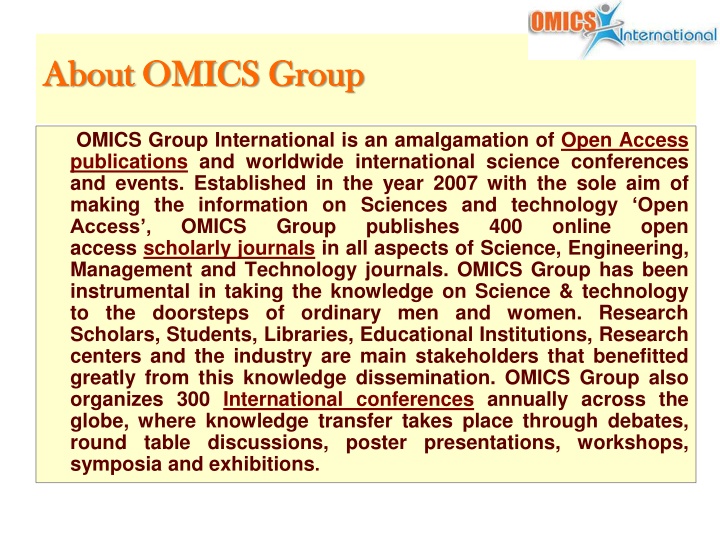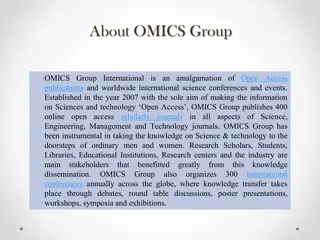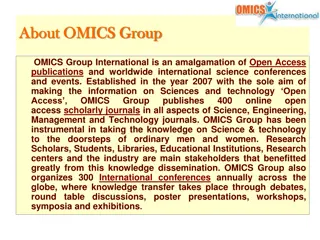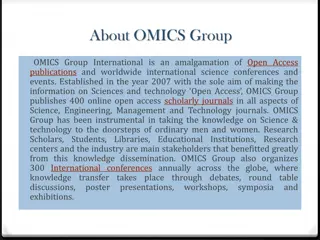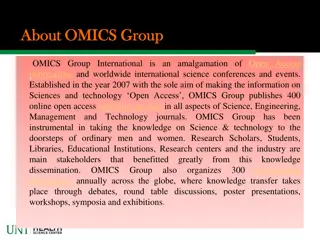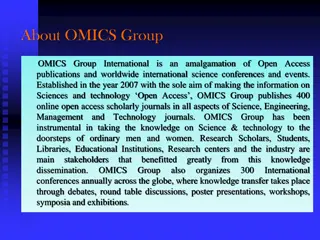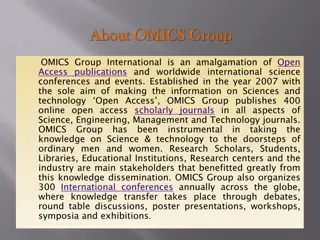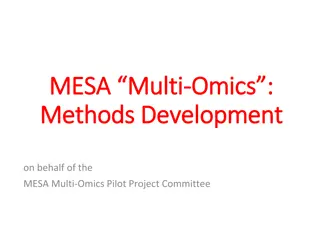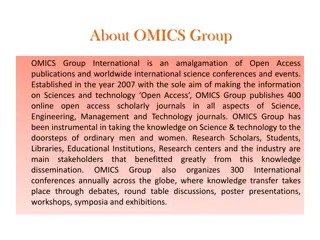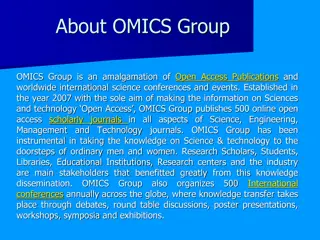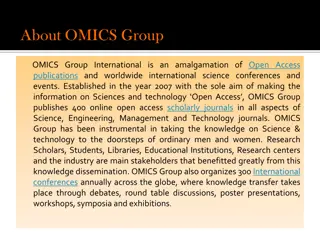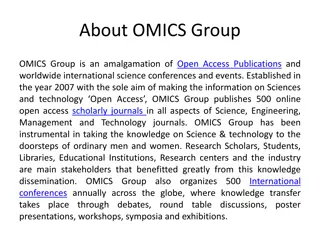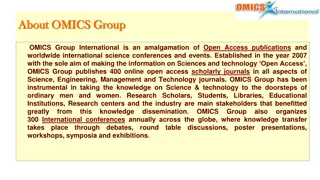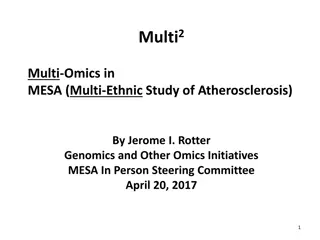About OMICS Group
OMICS Group International, established in 2007, focuses on making science and technology information easily accessible through open access publications and global science events. With a wide range of scholarly journals in various fields, OMICS Group serves researchers, students, and industry stakeholders worldwide. The group organizes over 300 international conferences annually, facilitating knowledge transfer through diverse platforms.
Download Presentation

Please find below an Image/Link to download the presentation.
The content on the website is provided AS IS for your information and personal use only. It may not be sold, licensed, or shared on other websites without obtaining consent from the author.If you encounter any issues during the download, it is possible that the publisher has removed the file from their server.
You are allowed to download the files provided on this website for personal or commercial use, subject to the condition that they are used lawfully. All files are the property of their respective owners.
The content on the website is provided AS IS for your information and personal use only. It may not be sold, licensed, or shared on other websites without obtaining consent from the author.
E N D
Presentation Transcript
About OMICS Group About OMICS Group OMICS Group International is an amalgamation of Open Access publications and worldwide international science conferences and events. Established in the year 2007 with the sole aim of making the information on Sciences and technology Open Access , OMICS Group publishes access scholarly journals in all aspects of Science, Engineering, Management and Technology journals. OMICS Group has been instrumental in taking the knowledge on Science & technology to the doorsteps of ordinary men and women. Research Scholars, Students, Libraries, Educational Institutions, Research centers and the industry are main stakeholders that benefitted greatly from this knowledge dissemination. OMICS Group also organizes 300 International conferences annually across the globe, where knowledge transfer takes place through debates, round table discussions, poster presentations, workshops, symposia and exhibitions. 400 online open
About OMICS Group Conferences About OMICS Group Conferences OMICS Group International is a pioneer and leading science event organizer, which publishes around 400 open access journals and conducts over 300 Medical, Clinical, Engineering, Life Sciences, Pharma scientific conferences all over the globe annually with the support of more than 1000 scientific associations and 30,000 editorial board members and 3.5 million followers to its credit. OMICS Group has organized 500 conferences, workshops and national symposiums across the major cities including San Francisco, Las Vegas, San Antonio, Omaha, Orlando, Raleigh, Santa Clara, Chicago, Philadelphia, Baltimore, United Kingdom, Valencia, Dubai, Beijing, Hyderabad, Bengaluru and Mumbai.
Anadolu University Faculty of Aeronautics and Astronautics Flight Control of a UAV Using Fuzzy Gain Scheduled PID Ahmet Ermeydan Ozan Durmaz Emre Kiyak Mech Aero 2015 3/12
Content Content Faculty of Aeronautics and Astronautics Introduction Fuzzy Logic Overview Pioneer UAV Fuzzy Logic Structure Table of Rules Airspeed, Altitude and Heading Responses Conclusion Mech Aero 2015 4/12
Introduction Introduction Faculty of Aeronautics and Astronautics Since the first flight of human being took place in the history, unmanned aerial vehicles (UAV) have been the focal point of aviation. Today UAVs have many applications fields such as remote inspection and monitoring, search operations, spy work, rescue and surveillance. In this work, the design of airspeed, altitude and heading controllers for Pioneer Unmanned Aerial Vehicle (UAV) aircraft is studied. A performance comparison between PID and Fuzzy-PID controllers designed for airspeed, altitude and heading are made. Mech Aero 2015 5/12
Fuzzy Fuzzy Logic Logic Overview Overview Faculty of Aeronautics and Astronautics Fuzzy Logic was developed in the seventies by Lotfi A. Zadeh, a professor at the University of California. Recently, fuzzy logic control has emerged as one of the most active and promising fields in the application of fuzzy set theory. There are now many technological products employing fuzzy logic, ranging from washing machines to high-speed trains. Mech Aero 2015 6/12
Pioneer UAV Pioneer UAV Faculty of Aeronautics and Astronautics RQ-2B Pioneer Length: 14 feet (4 m) Height: 3.3 feet (1.0 m) Weight: 205 pounds (452 kilograms) Wingspan: 16.9 feet (5.2 m) Speed: 110 knots (200 km/h) Range: five hours at 100 nautical miles (185 kilometers ) Mech Aero 2015 7/12
Fuzzy Fuzzy Logic Logic Structure Structure Faculty of Aeronautics and Astronautics Mech Aero 2015 8/12
Table Table of Rules of Rules Faculty of Aeronautics and Astronautics When |e| is bigger value, Kp should be bigger, Kd should be smaller for better tracking performance and the Ki should be set to zero for avoiding integral saturation and heavier overshoot. When |e| and |ec| are middle value, neither Kp, Ki and Kd is too large for slight overshoot. Ki should be smaller while Kp and Kd should be moderate for rapid response. When the |e| is smaller value, both Kp and Ki should be increased for better steady performance .Kd should be moderate for avoiding oscillation around the corresponding static value. Mech Aero 2015 9/12
Airspeed Airspeed Response Response Faculty of Aeronautics and Astronautics 62 Fuzzy PID PID 60 58 Airsped (m/s) 56 54 52 50 48 0 100 200 300 400 500 600 Times (s) Mech Aero 2015 10/12
Altitude Altitude Response Response Faculty of Aeronautics and Astronautics 66 Fuzzy PID PID 64 62 60 Altitude (m) 58 56 54 52 50 48 0 100 200 300 400 500 600 Time(s) Mech Aero 2015 11/12
Heading Heading Response Response Faculty of Aeronautics and Astronautics 0.14 Fuzzy PID PID 0.12 0.1 0.08 Heading (rad) 0.06 0.04 0.135 Fuzzy PID PID 0.02 0.13 0 0.125 -0.02 0 100 200 300 400 500 600 0.12 Time (s) 0.115 Heading (rad) 0.11 0.105 0.1 0.095 0.09 0.085 380 400 420 440 460 480 500 520 540 560 580 Time (s) Mech Aero 2015 12/12
Conclusion Conclusion Faculty of Aeronautics and Astronautics In this study a fuzzy gain scheduled PID controller is designed and implemented to an UAV autopilot system in SIMULINK environment. The control of airspeed, altitude and heading parameters of UAV is performed using both PID and Fuzzy-PID. Results show that changing controller gains dynamically gives a better performance than fixed gain values. It should be noted that these results can be improved with a better tuning of the fuzzy logic parameters. Mech Aero 2015 13/12
Anadolu University Faculty of Aeronautics and Astronautics Mech Aero 2015 14/12
